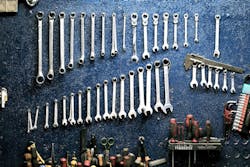The bottom line is that it’s not one shop fits all, says Philipp Lomboy, founder of Marami Marketing Group.
In Los Angeles, Lomboy says there are speciality shops working on high-end, custom cars. The owners of those vehicles have disposable incomes and might be more willing to spend large amounts of money and travel longer distances to get their vehicles repaired.
However, that customer base might not exist in, say, Omaha, Neb.
That’s exactly why Lombay says it is essential for a shop owner to dive into his or her customer demographics and create an ideal customer profile. He says at the end of the day, you need actionable information off of which to make smart business decisions.
“It ultimately comes down to what’s your audience, who has access to them and how can you cultivate those relationships with the informative sources,” he says.
Lomboy had a marketing agency for the last nine years and has helped turn around the marketing strategies of his dental and chiropractic clients, the strategies for which are the same for collision repair.
In order to identify your shop’s target demographic and ultimately form an ideal customer profile, Lomboy says it begins with taking an internal look at the shop.
As told to Melissa Steinken
Step 1: Identify how you want to grow.
If you are looking to craft a marketing message in the long run, it is important to know who you want your message to reach and in what way. Ask yourself what you’re looking to gain from an ideal customer base.
For example, if you just use location—say the car owners within two miles of your shop—your message can be, “The closest, certified shop in your neighborhood.” If you pinpoint age, your message targeting senior citizens could be, “A comfortable, friendly environment designed just for our senior citizens.”
The more specific you can get in your audience and messaging, the better your chances of success. You want your customers to think to themselves, “Yes, that’s for me.”
Step 2: Narrow your audience.
Take a look at the people with whom you are already doing business. You might not have a ton of information about your customers but you should have their name, address, phone number and a record of the work you did for them in your database.
Then, think about what you liked about that particular customer. Were they pleasant? Did they pay on time? Did you enjoy repairing their vehicle? Note when you liked working with a certain customer and keep track of those customer’s details. Do not waste money searching for demographic information on customers or vehicles you do not like.
Step 3: Access the information.
You can go to a list broker to find this information. Gain as much info as you can from the list broker. Match your data with the list broker’s data. The main types of data to search for should be income levels and the location of the customers.
Another useful tool in today’s age is Facebook. Facebook collects the data from its users so it can be a direct line to the people visiting your shop’s page. You’ll have direct access to their demographic data. Even if you have some past customer information in your shop’s management system, you can import that information into Facebook. And if you have a page that customers and viewers can like, you’ll be able to see more information from those “likes.”
You can even approach your insurance agent or adjuster. Typically, insurance companies will have already collected this data. You can approach this relationship and access this data by simply sending a newsletter to the agent, in which the business practices are detailed. Offer the agent something and they’re more likely to offer you the demographic information.
Step 4: Create a customer profile.
Now that you have gathered the information, you can form your “customer profile” or “lookalike customer.” This will be a model of the type of customer you are trying to reach through your advertising message.
Humanize the profile. Get a picture of a person you imagine is a good representative of your target demographics. Give that person a name. For this example, let's go with a photo of a 38-year-old woman named Janet. Get a picture of this person's day-to-day life. What is Janet's home or work life like? What does her typical week look like? Is she married? How many kids does she have? What responsibilities does she have? Where does she shop? Does she use coupons?
Answer these questions and others like them so that you can start getting an understanding of the person's real, rational, everyday needs and where your service might fit into the picture.
Step 5: Revise and track the numbers.
Always go back to the process of asking, “Who is my ideal customer?” Once per quarter, take a look at the information and the “lookalike” customer profile you have created. This can happen any time during the quarter and does not have to be scheduled for the first day of each period.
If you realize your bays are empty, then go back and restructure the information you’re using to market to your customers. Tracking this information can get a bit tricky so you’ll have to get your hands “dirty.”
Start asking your customers questions. Ask the customer how they heard about you. If they respond with “the Internet,” do not give them a third-degree interrogation. Simply note that and then compare it with how many other people in the same area heard about the shop through the same channel.




